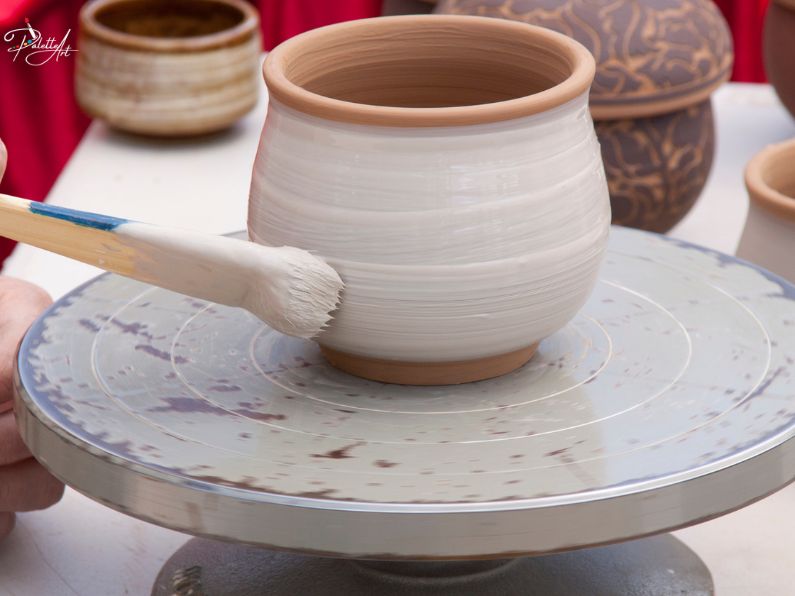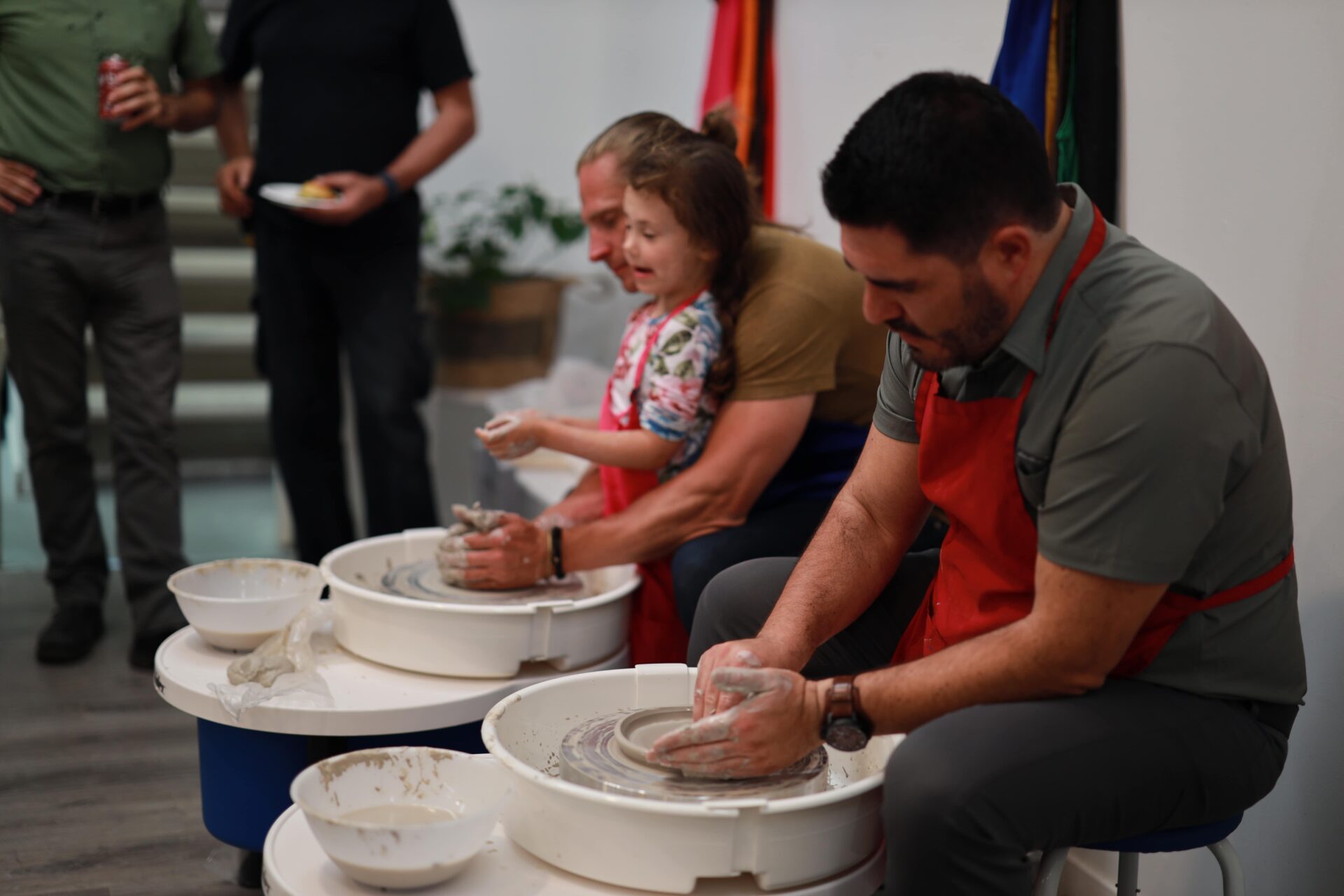Pottery painting is a timeless art form that allows individuals to express their creativity through beautiful designs and patterns. Central to this craft are brush strokes in pottery painting, which can transform a simple piece of pottery into a unique work of art. By mastering various brush stroke techniques, artists can create intricate designs, textures, and even achieve effects like the marble effect in pottery painting.

Contents
- 1 Understanding Pottery Painting
- 2 History and Evolution of Pottery Painting
- 3 Importance of Brush Strokes in Pottery
- 4 Getting Started with Pottery Painting
- 5 The Basics of Brush Strokes
- 6 Mastering Different Brush Strokes
- 7 Advanced Brush Stroke Techniques
- 8 Enhancing Your Pottery with Brush Strokes
- 9 Maintaining Your Brushes
- 10 The Creative Process in Pottery Painting
- 11 Pottery Painting Projects for Practice
- 12 FAQs
Understanding Pottery Painting
Pottery painting involves applying colorful glazes or paints to ceramic pieces, followed by firing them in a kiln to set the design. Brush strokes in pottery painting play a crucial role in defining the final look of the piece. Whether you’re aiming for delicate lines or bold patterns, understanding how to control your brush strokes will significantly impact your work.
History and Evolution of Pottery Painting
The history of pottery painting dates back thousands of years, with ancient civilizations using simple brushstrokes to decorate their wares. Over time, techniques have evolved, and today’s artists have a plethora of brushes and tools at their disposal to create more sophisticated designs, including achieving the marble effect.
Importance of Brush Strokes in Pottery
Brush strokes in pottery painting are fundamental because they determine the texture, depth, and overall aesthetic of the piece. Each stroke contributes to the final design, making it essential for artists to practice and perfect their techniques. Mastery of brush strokes can elevate a basic piece of pottery into an exquisite work of art.
Getting Started with Pottery Painting
Essential Tools and Materials
To begin your journey into pottery painting, you’ll need a few essential tools and materials. These include various types of brushes, glazes or paints, a palette, water containers, and, of course, the pottery pieces themselves. The right tools will help you achieve the desired brush strokes in pottery painting.
Types of Brushes and Their Uses
Different brushes serve different purposes. Round brushes are great for detailed work and fine lines, while flat brushes are ideal for broader strokes and shading. Understanding the uses of each type of brush is crucial for executing effective brushwork.
Preparing Your Workspace
A well-organized workspace is essential. Ensure you have enough space to comfortably move your brushes and pottery pieces around. Proper lighting will also help you see your brushstrokes clearly, enabling you to create more precise designs.
The Basics of Brush Strokes

Understanding Brush Stroke Techniques
Brush stroke techniques vary widely, from simple lines to complex patterns. The way you hold your brush, the amount of pressure you apply, and the angle of the brush all affect the resulting brush strokes in pottery painting. Experimenting with these variables will help you understand their impact on your work.
Common Brush Strokes in Pottery Painting
Some common brush strokes include the linear stroke, the dot, and the splash. Each of these can be used to create different effects and textures on your pottery. Practicing these basic strokes will lay the foundation for more advanced techniques.
Practice Exercises for Beginners
Begin with simple exercises to practice your brushwork. Try painting straight lines, curves, and dots on a test piece of pottery. These exercises will help you gain control over your brush and improve your technique over time.
Mastering Different Brush Strokes

Linear Strokes and Their Applications
Linear strokes are the building blocks of many designs. These brushstrokes can be used to create borders, patterns, and intricate details. Practicing consistent linear strokes will improve your overall painting skills.
How to Create Dots and Splashes
Dots and splashes add texture and interest to your pottery designs. By varying the pressure and angle of your brush, you can create different sizes and shapes of dots. Splashes can be achieved by flicking the brush, adding a dynamic element to your brushwork.
Using Strokes to Create Textures
Different brushstrokes can be used to create various textures on your pottery. Experiment with techniques like dry brushing, stippling, and blending to add depth and interest to your designs.
Texturing your pottery with brush strokes in pottery painting can add depth and dimension to your designs. Experiment with different brush types and techniques to create textures such as cross-hatching, stippling, or even the marble effect in pottery painting.
Advanced Brush Stroke Techniques

Layering Brush Strokes for Depth
Layering brushstrokes allows you to create depth and richness in your designs. By applying multiple layers, you can achieve complex patterns and a sense of dimension that brings your pottery to life.
Creating Gradients and Shading
Gradients and shading add realism and interest to your pottery. These advanced brushwork techniques require careful blending of colors and precise control of your brush to achieve smooth transitions and shadows.
Combining Brush Strokes for Complex Patterns
Combining different brush strokes in pottery painting can result in stunning, intricate patterns. Mixing linear strokes, dots, splashes, and textures allows you to create unique designs that showcase your artistic skills.
Enhancing Your Pottery with Brush Strokes
Personalizing Your Pottery with Unique Strokes
Your brushwork can reflect your personal style. Experiment with different techniques to develop a signature look that makes your pottery stand out. Personalized brushwork adds a unique touch to each piece you create.
Techniques for Consistency and Precision
Consistency and precision are key to mastering brushwork. Practice steadying your hand and maintaining even pressure to achieve uniform strokes. This will result in cleaner, more professional-looking designs.
Troubleshooting Common Mistakes
Mistakes are a natural part of the learning process. If you encounter issues with your brushwork, such as uneven lines or smudges, take the time to analyze what went wrong and adjust your technique accordingly.
For additional insights and inspiration, you can refer to Emily Carr University of Art + Design in Vancouver. They offer a wide range of programs and courses in art and design, fostering a vibrant artistic community.
Maintaining Your Brushes

Cleaning and Storing Brushes Properly
Proper maintenance of your brushes is crucial for achieving consistent brush strokes in pottery painting. Clean your brushes thoroughly after each use and store them in a way that preserves their shape. This will extend the life of your brushes and ensure they perform well over time.
Extending the Life of Your Brushes
To prolong the life of your brushes, avoid leaving them in water for extended periods and use brush cleaners when necessary. Taking good care of your brushes will help you maintain the quality of your brushwork.
The Creative Process in Pottery Painting
Finding Inspiration for Your Designs
Inspiration for your pottery designs can come from many sources, including nature, architecture, and other art forms. Observing different patterns and textures can give you ideas for new brush strokes in pottery painting that you can incorporate into your work.
Sketching and Planning Your Patterns
Before applying brush strokes, sketch out your designs on paper. Planning your patterns helps you visualize the final piece and ensures that your brush strokes are purposeful and well-executed.
Applying Brush Strokes to Large Surfaces
Painting large surfaces requires a different approach than smaller pieces. Use broader brush strokes and plan your design to ensure even coverage. This technique helps maintain consistency across the entire piece.
Pottery Painting Projects for Practice
Simple Projects for Beginners
Start with simple projects to practice your brush strokes. Items like small plates, mugs, or tiles are perfect for beginners. Focus on basic techniques and build your confidence as you progress.
Intermediate Projects to Hone Your Skills
As you become more comfortable with your brush strokes, move on to intermediate projects. Try painting more complex patterns on larger pieces, such as vases or bowls. These projects will challenge you and help refine your skills.
Advanced Projects for Mastery
For advanced practitioners, tackling intricate designs and large-scale pieces is the next step. Mastering advanced brush strokes in pottery painting will enable you to create stunning works of art that showcase your expertise.
At Palette Art studio, we offer Pottery Classes for Adults and Pottery Classes for Kids. If you are interested in pottery, you can participate in these classes. For those who prefer pottery painting, simply reserve a time at our studio or become a permanent member and enjoy pottery painting anytime. Join us and create happy moments!
FAQs
What are the best brushes for pottery painting?
The best brushes for pottery painting are those specifically designed for ceramic work, including round, flat, and detail brushes.
ow can I achieve consistent brush strokes?
Achieve consistent brush strokes by practicing regularly, maintaining even pressure, and using high-quality brushes.
Can I use regular paintbrushes?
While regular paintbrushes can be used, brushes designed for pottery often provide better results and durability.
How do I fix mistakes in brush strokes?
To fix mistakes in brush strokes, gently wipe off the error with a damp sponge before the paint dries and reapply the correct stroke.
What techniques can I use to create unique textures?
Create unique textures by experimenting with different brush types, varying pressure, and using techniques like stippling, cross-hatching, and the marble effect in pottery painting.
How do I properly clean my brushes after painting?
Clean your brushes thoroughly with water and mild soap, reshape the bristles, and store them properly to maintain their quality.
By mastering the basics of brush strokes in pottery painting, you can elevate your pottery to new heights. Whether you are a beginner or an advanced artist, understanding and practicing these techniques will help you create beautiful and unique pieces that reflect your personal style.


